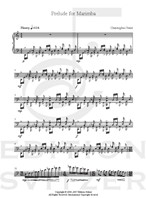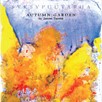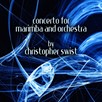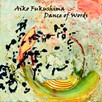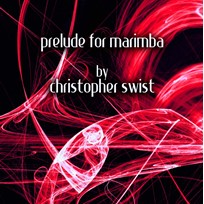
Prelude for marimba
Composer: Christopher Swist
Instrument: Marimba
Level: Advanced
Published: 2007
Price: €16.00
Item details
-
Description +
-
Duration: 5 min.
Prelude for Marimba was written in late 2006 and premiered in February of 2007 in New Hampshire. Having written a great deal of material for solo marimba from 1996-2001 I had taken a 5-year break from marimba solos. The most obvious development after this hiatus was that this was my first piece to encompass a 5-octave marimba. Given this extended range, it is not a surprise that much of the piece focuses on the low-end of the instrument. The prelude uses a pair of 6-note modes that form the 12-tone aggregate. The form is A-B-A with the driving rhythmic "A" sections framing an open abstract "B" section that incorporates an alternative tone row. Tempo alterations and dynamic contours are scored to encourage the performer to play expressively and with great finesse. As well, the abstract "B" section allows for a certain degree of rhythmic and dynamic embellishment on behalf of the performer.
Christopher Swist
-
-
Instrumentation +
-
Marimba
-
-
About the composer +
-
Christopher Swist spends equal time as a percussionist, composer, engineer, writer, and educator. His music education started at age 6 with Buffalo Philharmonic percussionist John Rowland and continued through multiple degrees in performance and composition from SUNY-Buffalo (Jan Williams) and The Hartt School (Ben Toth and Al Lepak). He culminated his unique compositional voice, performance practice, and recording engineering into 2 solo albums: Whitewater of 2001 and Duality of 2013. His third solo album, Equal Simplicity, is being released in 2025.
Christopher’s varied catalog of orchestral, concerti, percussion, chamber and electronic music is published with Alfred Music, Studio 4 Music, Keyboard Percussion Publications, Edition Svitzer, and Bachovich Music. Swist’s latest work is a Double Concerto for Vibraphone and Marimba that he also performs as the vibraphone soloist. His music has been performed by the Grand Rapids Symphony, Hartford Symphony Orchestra, The Louisville Orchestra, American Modern Ensemble, Grupo PIAP, YoungArts, and the United States Military Academy. He also presents recitals as a performer/composer who plays both acoustic and electronic music.
Christopher is a symphonic musician as well, performing in the percussion sections of symphony orchestras in Hartford, New Haven, Springfield, Waterbury, Bridgeport, Ridgefield, and Norwalk. He has been the principal percussionist of the New Britain Symphony Orchestra since 1999 and directs the NBSO’s educational outreach programs and steel pan/percussion fusion ensembles.
Professor Swist is an educator, pedagogue, and administrator. He is Director of Recording Arts at Trinity College in Hartford. He also designed and built EvenFall Studio LLCin New Hampshire, and, is a pro audio writer/reviewer for SonicScoop. Christopher was recently inducted into the Buffalo Music Hall of Fame.
-
-
Reviews +
-
Review (Percussive Notes, March (58) 2012)
A 5.0-octave marimba offers a menacing low range, which this piece capitalizes on throughout its five minute duration. Composed in an idiomatic fashion for four mallets, “Prelude for Marimba” offers the listener and performer passages of intensity and aggression that are juxtaposed with moments of freedom and flexibility.
Constructed in an ABA form, the piece begins with a variety of driving rhythmic patterns, with melodic fragments derived from a tone row. The combination of single independent and double vertical strokes create lines that alternate between being nimble and heavy. The middle section is marked by a slower tempo, more spacious rhythms, tremolo passages, and indications of greater interpretive freedom. Here, a new tone row is introduced, creating fresh material while maintaining the “angular” tonalities of the first section. The final section employs replication of passages from the opening of the piece, while also introducing new rhythmic variations that serve to drive the work to its energetic conclusion.
Although the performer must possess an advanced level of physical technique to execute this piece, all stickings (while not notated in the score) would be fairly obvious, due to the idiomatic, “marimba friendly” nature of the scoring. This piece would serve as a fine opening selection on a recital, or for those looking to christen the low end of their new five-octave instrument.—Jason Baker
____________Benjamin Toth, Professor of Percussion The Hartt School, University of Hartford
Christopher Swist's marimba writing in his "Prelude" is idiomatic yet unpredictable. He beautifully exploits the full range of the instrument, exploring a broad spectrum of colors and articluation.
-
-
Credits +
-
Front cover artist: Ronni Kot Wenzell
Performing artist: Christopher Swist
Copyright © Edition Svitzer
Printed in Copenhagen, Denmark
-
